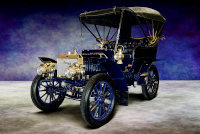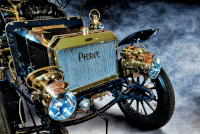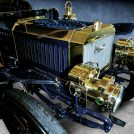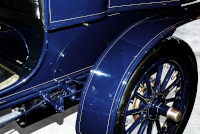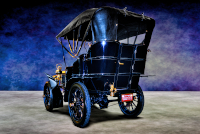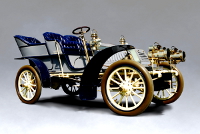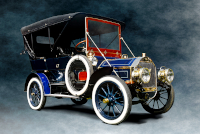Location:
RM Sotheby's, Hershey, 2019
Owner: John & Linda Muckel | Rancho Palos Verdes, California
Prologue:
While the Muckel family brought this 1904 Arrow to auction in 2019, the Bill and Jean Irr Family Foundation purchased the car and donated it to the Buffalo Transportation and Pierce-Arrow Museum.
I traveled to that RM Sotheby's auction in 2019, this year looking for a number of exquisite brass era cars. Not Pierce-Arrow alone, I harbor a great fondness for the brass era, even as the glamor of Art Deco design holds the greatest sway on the concours lawn and the allure of mid-century sports cars teases our lingering sense of nostalgia. In comparison, the brass era is a mechanical jewelry box. And yet these cars are also fantastically practical. A Pierce-Arrow (or Pierce) from this period is extremely durable, and its extreme durability justified its extraordinary cost. Much like Rolls-Royce, Pierce stood well above industry standard. So I looked forward to spotting this California-based car, knowing that it fits between the lone 1903 motorcar and the expanded Great Arrows to follow. I believe only two such 1904 cars exist, this tonneau and a runabout in the Henry Ford Museum collection. I could not pass up a chance to collect a few photographs.
- - - - - - - - - -
► Image Source: Nikon D750 (24.3 MP)
References:
- Ralston, Marc. "Pierce-Arrow" A.S. Barnes & Co., Inc., San Diego, CA. 1980, page 13-14, 23-25, 230
- RM Sotheby's: The auction description focuses mainly on owner history.
- Western New York Oldsmobile Club: News of the Arrow's donation to the Buffalo museum.
The 1904 Model 15-J advances the Pierce motorcar platform in two characteristics. First, the 1904 model replaces 1903's De Dion motor with a Pierce-built 2-cylinder motor. Second, the Renault-style bonnet disappears in favor of a square unit. At the front sits a proper radiator, which Pierce sources from the Whitlock Coil Pipe Company of Hartford, Connecticut, identified on the rectangular makers plate. Altogether, the Arrow follows chief engineer David Fergusson's original plan, though the 15-J is a transitional exercise between the Motorette buggies in production since 1901, and the Great Arrow soon to follow in 1904. So it is that only three Arrows survive from 1903 and 1904 combined.
Pierce's 1904 advertising for the Model 15-J claimed, "A motor car is an investment not for a week or a month, but for a lifetime. Use judgment now." This particular advert, printed in Marc Ralston's Pierce-Arrow history, implores the prospective buyer to research Pierce's endurance trial record to "understand why we are so much in earnest" regarding the car's worth. Pierce wants the public to read its press release on the 800-mile New York to Pittsburgh Endurance Test, which the company competed in 1903 with a Model 8-M Stanhope, and in 1904 with a 15-J.
No matter Pierce's stellar performance, the irony is that the motorcar is such a new proposition and technology will evolve so rapidly that in just five years a new Pierce-Arrow will vastly outmode the original Arrow. Later 20th century Americans will experience the same trend with the dawn of the personal computer. That said, Pierce's business ethic did hold to the strict standards promised in its advertising. Pierce built the most durable motorcar, proved its durability in endurance trials, and quickly covered the gap from buggy to luxury automobile.
Motor: Pierce 2-cylinder, cast iron | 100 mm x 109.5 mm
Power: 15 hp
Drivetrain: 3-speed progressive column-shift bevel gear transmission, shaft drive to the rear wheels
Front Suspension: compound leaf springs
Rear Suspension: compound leaf springs
Architecture: pressed steel frame with detachable tonneau section
Kerb Weight: 861.8 kg (1,900 lbs)
Wheelbase: 2,057.4 mm (81 inches)
Etymology:
'Pierce' is shorthand for the marque. The names 'Arrow' and 'Great Arrow' identify top-range models. (In 1908, 'Arrow' will be added to the name of the marque itself.) Pierce used an alpha-numeric model system from 1901. The Model 15-J slots in among the more prolific runabout buggies, which the company continued to produce through 1904, ending with the Model 8-M Stanhope Motorette. Numbers indicate horsepower and letters the relative sequence of production. The term 'rear-entrance tonneau' refers to a passenger compartment accessed by a hinged door at the back. 'Tonneau' is carriage-speak for the rear seat section, from the French, which translates to 'barrel' in English.
Figures:
Pierce produced 75 Model 15-J cars in 1904. Only three Model 15-Js survive from the entire production run from 1903-1904 (a total of 124 cars). Of these, we profile two in our portfolio; the third is a 1904 runabout owned by the Henry Ford Museum.
Value:
When new in 1904, a Model 15-J cost $2,500, which is roughly the cost of one Phare Solar headlamp today. The Phare Solar lamps on this Pierce are particularly elaborate, however, so in this case the cost is probably much higher per fixture.
This car sold at RM Sotheby's Hershey auction in 2019 for $236,500.
The Pierce previously sold at Gooding & Company's 2008 Pebble Beach auction for $165,000.
New Identity: Modernized Radiator of the 1904 Pierce
It might be difficult to picture because the 1904 car wears a complete hood, but the 1903 and 1904 Arrows are largely similar. The wheelbase is the same, as is the detachable tonneau compartment. The fenders use the same template. However, the modernized radiator and bonnet change the character entirely. The 1904 Model-J is no longer a French acolyte, but an important step from that first complete motorcar to the Great Arrow soon to follow the same year.
Rear-Entrance: Depicting the Tonneau
What we do not depict on the 1903 car we can show here, the beautiful tonneau section at the back. I can report that the hinges and hardware on this 1904 car are greatly simplified, much less ornate, with one lantern rather than two attached to the frame. These differences may be a matter of the particular car, and not a difference of model year. Also of interest, the rear-entrance plan requires the rear window (not so much a window as a vestibular gap) to accommodate ingress and egress. A flap enclosure can be unrolled to cover the gap as needed.
Last Updated: Mar 26, 2025

